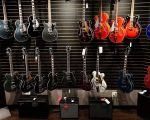
Unlocking the Power of Data Analytics for Effective Music Promotion
As an artist or music marketer, one of the biggest challenges we face today is standing out in an oversaturated market. Whether you're an independent musician or a well-established artist, the key to success in music promotion lies in how well you understand and utilize data analytics. In the digital age, data analytics has become an essential tool for tracking audience behavior, optimizing marketing strategies, and ultimately driving your music career to new heights. But how do we actually leverage data analytics to our advantage? Let me take you through the key steps to help you effectively use data to promote your music in the U.S. market.
1. Understanding Your Audience Through Data
When you think about music promotion, one of the first things that come to mind might be social media marketing or streaming platforms like Spotify. While these are undoubtedly important tools, they also offer a wealth of data that can help you better understand your audience. It’s no longer just about posting your latest track and hoping it goes viral. Instead, we can dive into insights like listening patterns, geographic locations, and even demographic data to tailor our campaigns.
For example, platforms like Spotify and Apple Music provide detailed analytics that show where your listeners are located, what times they’re listening, and even which tracks they skip the most. By analyzing this data, you can target specific regions or demographics that are more likely to engage with your music. You can also experiment with release times and promotional campaigns based on peak listening times.
2. Optimizing Your Marketing Campaigns with Analytics
Once you understand your audience, the next step is to use this data to inform your marketing campaigns. Gone are the days of using a one-size-fits-all approach. With data analytics, you can personalize your music marketing efforts, ensuring that your message reaches the right people at the right time.
Take social media platforms, for instance. Facebook, Instagram, and TikTok all offer analytics that can help you understand the performance of your posts. These platforms provide valuable metrics such as engagement rates, click-through rates, and the demographic breakdown of your followers. By analyzing these metrics, you can refine your content strategy to create posts that resonate more with your target audience.
Let me share a story of an independent artist I worked with. He was struggling to grow his fanbase, despite consistent efforts on Instagram. However, after analyzing his data, we discovered that his audience was more active on TikTok, and his Instagram posts were mostly reaching older users. With this insight, we shifted our focus to TikTok, where his engagement rates shot up by over 30%. This shift wasn’t random; it was driven entirely by data analytics.
3. Utilizing Data to Boost Your Streaming Numbers
Streaming platforms are not just for listening to music—they’re also powerful tools for tracking listener behavior. The data these platforms collect can give you a detailed picture of how your music is performing. By using this information, you can adjust your promotional efforts to increase streams, followers, and even chart performance.
Let’s take Spotify as an example. With Spotify for Artists, you can track your performance in real-time. You can see where your listeners are located, which playlists your songs are featured on, and how your streams are trending. You can even analyze the flow of listeners from one track to another, allowing you to fine-tune your playlist placement or song releases for maximum impact.
For instance, if you notice that your latest track is getting a lot of attention from listeners in a particular city, you can create localized ads targeting that region. Additionally, you can reach out to playlist curators to get your song added to high-traffic playlists that your target audience is listening to.
4. Making Data-Driven Decisions for Long-Term Success
One of the biggest advantages of using data analytics for music promotion is that it allows you to make informed decisions that lead to long-term success. Instead of guessing which marketing strategies will work, data allows you to make choices based on hard evidence. You can experiment with different promotional tactics, track their effectiveness, and refine your approach accordingly.
In my own experience, one of the most beneficial ways to use data is to regularly monitor your key performance indicators (KPIs). These might include metrics like streams, social media engagement, website traffic, or ticket sales. By setting specific goals for each of these KPIs, you can continuously track your progress and adjust your strategies as needed.
For example, if your goal is to increase streams on a particular platform, you might test different advertising strategies, timeframes, or creative approaches. Using the insights gathered from these experiments, you can fine-tune your marketing efforts and focus on strategies that bring the best results. This ongoing process of testing and optimizing is what leads to sustainable growth in your music career.
5. Collaborating with Data-Driven Partners
Another powerful way to leverage data analytics for music promotion is by partnering with industry professionals who specialize in data-driven marketing. Music promotion companies, digital marketing agencies, and even independent consultants can help you make sense of the vast amount of data at your disposal and craft a customized marketing strategy that works for you.
For example, some companies use sophisticated algorithms to predict which songs will perform best based on past listener behavior. These predictions can help you determine which singles to promote, which genres resonate most with your audience, and which promotional channels to prioritize. By collaborating with these experts, you can get a clearer picture of how to promote your music most effectively in a crowded marketplace.
6. Keeping Track of Trends and Evolving with Data
The music industry is constantly evolving, and staying ahead of trends can be difficult. However, with the right use of data analytics, we can spot trends early and adjust our promotional strategies to capitalize on them. Whether it’s a sudden spike in interest for a particular genre, an emerging social media platform, or a new listener behavior pattern, data helps us stay on top of changes and adapt quickly.
For example, TikTok’s influence on music promotion is a perfect case of how data analytics can help artists stay ahead. By analyzing the content that’s going viral on TikTok, we can predict which types of music or themes might gain traction. Artists who are quick to recognize these trends and adapt their promotional strategies are more likely to ride the wave of popularity and gain exposure to a broader audience.
As we continue to see rapid technological advancements in the music industry, the role of data will only become more crucial. From predicting the next big hit to crafting highly-targeted marketing campaigns, data analytics is the key to driving success in music promotion.
Ready to take your music promotion to the next level? Start by diving into the data available to you, and let it guide your next steps. By using data-driven insights to inform your strategy, you’ll unlock new opportunities for growth, increase engagement, and ultimately reach a wider audience.
For the best instruments, services, or even music marketing tools, be sure to check out Beat Trigger for expert recommendations and high-quality gear tailored to your needs!








